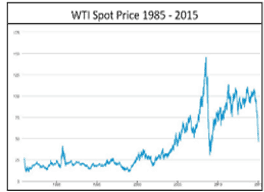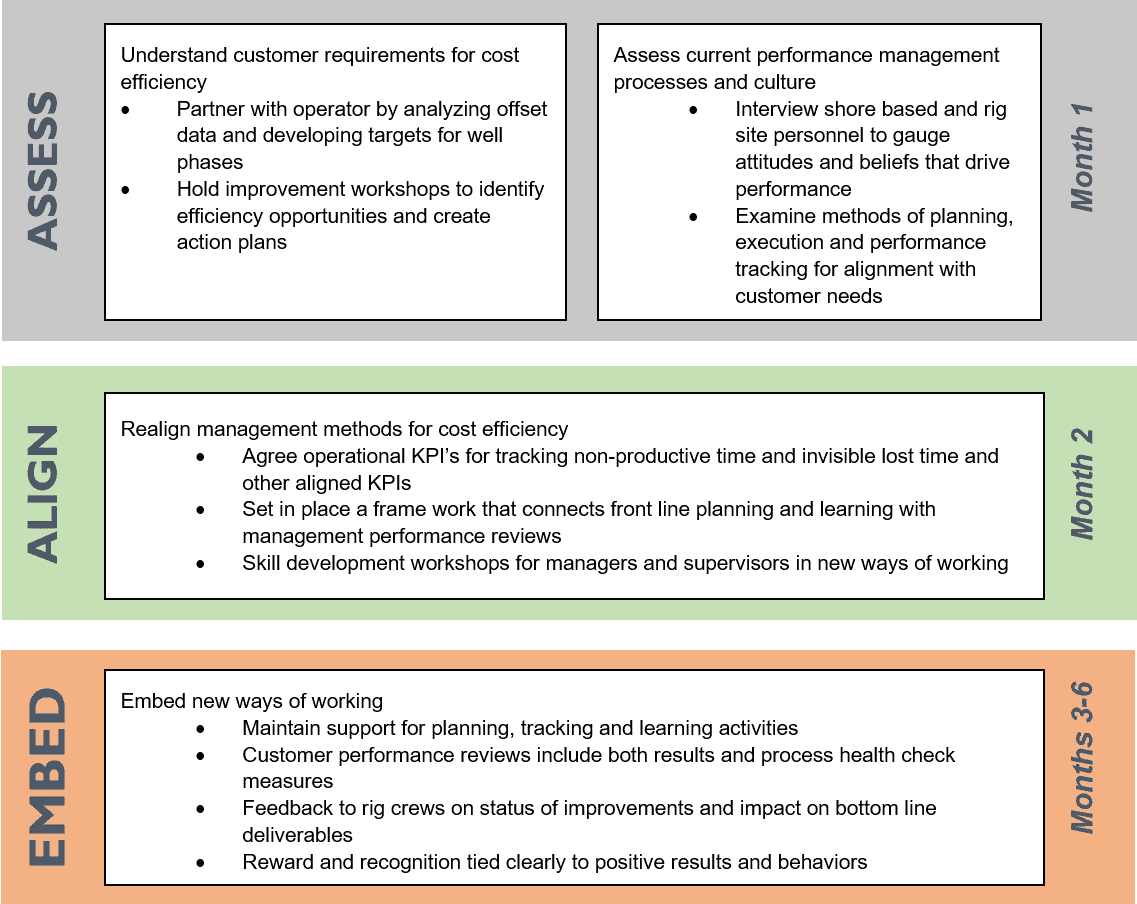
“We are looking for Drilling Contractors that take ownership in continuously improving time on well performance. The attitude that ‘it takes as long as it takes’ is no longer viable, especially when evaluating development of deep water, high cost prospects”…Drilling Manager, GOM.
“Working safe is an absolute baseline expectation. With that said, our revised mission statement reflects a total focus on driving out cost through efficient operations. Working safe does not mean our contractors can remain status quo in efforts to reduce costs associated with managing total time-on-well”…Performance Manager, GOM.
Drilling Contractors are experiencing a revolutionary shift in their industry resulting from sustained cost pressures and shifting customer expectations as Operators seek to remain profitable despite a return long-term, lower crude prices.
The dramatic increase in crude price beginning in 2005 that masked Operators’ need to focus on reducing well construction costs coincided with increased pressure to improve personal safety performance and, post-Macondo, more stringent and costly well integrity requirements. High demand for new generation drilling rigs saw contractors rewarded with increasing day rates without expectation for corresponding efficiencies in controllable time / cost factors such as flat time performance and between well maintenance intervals.
The dramatic increase in crude price beginning in 2005 that masked Operators' need to focus on reducing well construction costs coincided with increase pressure to improve personal safety performance and, post-Macondo, more stringent and costly well integrity requirements. High demand for new generation drilling rigs saw contractors rewarded with increasing day rates without expectation for corresponding efficiencies in controllable time/cost factors such as flat time performance and between well maintenance intervals.

The inevitable correction of crude prices that began in 2014, and the industry wide cost re-structuring, will drive unprecedented requirements for Drilling Contractors to embrace a new reality of customer focus and cost efficiency. These are the same fundamentals experienced across industries as diverse as manufacturing and services and, learning from other industries, Drilling Contractors can differentiate their offer and become suppliers of choice by adopting proactive approaches to driving out waste and non-value added costs. Companies who embrace this approach and see their success through the eyes and needs of their customers will thrive, while those who stand by denial and wait for the good times to return will become obsolete.
Economics Professor and Scholar of the American Enterprise Institute, Mark Perry, writes that “ 88% of Fortune 500 companies in 1955 have either gone bankrupt, merged, or fallen from that list by 2014” and that “fifty years ago, the life expectancy of a firm in the Fortune 500 was around 75 years. Today, it’s less than 15 years and declining all the time.” Clearly past success is no longer a guarantee of future growth, or even survival, for firms who might be market leaders today.
Former industry leading companies, as iconic as General Motors, have been pushed to the edge of survival and only through massive government support were given a lifeline to produce only what is relevant in the eyes of their customers and to drive out non-value added waste.
Foreign auto makers pioneered lean, customer focused approaches to manufacturing and have reaped the rewards, by expanding market share at the expense of firms like GM whose management clung to over confidence about consumer preferences and lived in denial of the obvious threats imposed by a more discriminating customer base.

My own experience with rapid industry change hit me like an unseen rogue wave when, early in my career, I was a maintenance manager for a large scheduled airline. Our maintenance team was entrepreneurial and was generating cash for the company through our aggressive pursuit of 3rd party maintenance contracts.
Despite our division’s profitability, we were dismissed by senior airline management as being unruly cowboys who were chasing business opportunities at the expense of supporting our own fleet.
The ‘old guard’ of management clung to their paradigms of how an airline should be run and condemned our audacity of entering into sharing agreements with competitors for costly critical spares, like engines, even though it improved our fleet reliability and reduced working capital tied up with inventory. At a management retreat the president openly disregarded a competitive threat posed by a recent start up airline and encouraged us to place bets as to how long they’d survive, “I give ‘em two weeks” he chided as he threw his money in the pot. I recall thinking that such arrogant and unfounded confidence was not what we needed in our leader, and, I’d rather have bet on the hungry upstart that was unencumbered by old ways and was appealing to customer preferences of no-frills, low cost air travel. A year later we, the established venerable airline were out of business and, 25 years later that upstart has grown to hold the second highest market share in the country.
How did the upstart thrive during a time when established firms like Branniff, TWA and Northwest were bleeding to death? By challenging long held sacred cows of ‘how to run an airline’
The status hierarchy in airlines has traditionally placed pilots as the most revered positions and, at the bottom end of the status hierarchy came the lowly ‘groomers’, those unskilled workers who clean toilets and tidy the cabin between flights. Grooming a plane is time consuming and impacts the airline’s ability to quickly turn around flights, but is essential for a quality in-flight experience in the eyes of customers.
Imagine my amazement, when, years later I boarded a flight operated by the upstart to meet a pilot who, along with the flight attendants, was grooming the cabin. “Of course we help to groom the plane because this helps turnaround flights quicker and when we fly sooner, we make more money…we don’t make money by sitting at the gate!”. The upstart doesn’t even employ groomers. Instead pilots and flight attendants take pride in their airplane and keep it clean between flights.

What lessons can history teach us as the inevitable wave of change begins to crash into the drilling industry?
Not long after joining a management consulting firm, I attended a talk by UC Davis management professor and author Robert Lorber. His central theme was that “management should not believe their own press clippings” and in order to survive in this era of unprecedented rate of change, must be humble and open minded to see their business through the eyes of customers and help employees understand their connection to bottom line success. He challenged us to identify what ‘sacred cows’ were preventing our ability to adapt and aiding our competitors, who were offering innovative approaches that improve both customer satisfaction and cost efficiency.
In our 15-year history as a drilling performance consultancy, rp2 has worked closely with operators world-wide to help make well delivery more efficient. We know what’s important to our customer base because we keep in close contact with them, and since we have the same customer base as drilling contractors, we’re uniquely placed to help contractors understand and deliver on the needs of these customers.
The quotes at the beginning of this article reflect what we increasingly hear Operators say about the changing landscape of the industry and what they need from The Drilling Contractors. The old days saw performance consultancies hired by operators in the hopes that we could engage the contractors’ workforce and identify ways to become more efficient.
Increasingly we’re hearing from Operators calling for their prime Contractors to own the continuous improvement process. You can bet they’ll even support the investment as long as you demonstrate a robust process with a clear link to the value unlocked. It’s not enough to increase rig site supervision and call the new positions ‘Performance Toolpushers’ without a fundamental shift in leadership vision and support throughout the organization.
In practical terms, you begin the journey by undertaking an unbiased assessment of your existing organizational culture and performance management practices. You’ll need to understand existing beliefs and attitudes across the organization that support or hinder performance excellence and whether your internal performance measures align with customer requirements. For example, rig downtime will impact your bottom line, but it is only one element of non-productive time and invisible lost time that impacts the operators’ bottom line. Acting on assessment findings will require you to be bold enough to tread into areas that traditionally were seen as the operator’s concern because delivering what’s important to your customer makes good business and differentiates you from the pack of competitors. Measuring efficiencies in flat times, running BOP’s and conducting between well maintenance now become your KPI’s, much to the delight of your customers whose shareholders demand an efficient use of capital. You are likely to find that your customer may share an interest in your company achieving some more of it's deliverables!! Imagine that.
Once you’ve clearly understood your customer needs and developed an aligned set of operational performance measures you’ll need to develop new performance management skills and build support across the organization. Continuous improvement is not something that can be delegated, it is ‘top-down driven’ with rig leaders held accountable to implement the process and yet requires ‘bottom-up engagement’ since those closest to the work are best placed to identify improvements for both efficiency and safety. New skills will be required by operations teams for effective pre-job planning and post-job after action reviews to ensure continuous learning and optimization of operating procedures. Management and supervisors must embrace that fact that they have more impact over their teams than they realize, and how to unleash that potential by identifying and reinforcing behaviours that lead to improved operating results.


A very in depth and informative article thanks Dave. In most companies we tend to see two types of people who can make a real difference. 1) Young people with fresh eyes who can often see opportunities for improvement. 2) Those with many years of experience who have encountered almost every situation before. The problem is that often young people are ignored, and the experienced are set in their ways. This is the reason why performances coaches such as yourself are so valuable. You have the wealth of experience, AND a fresh set of eyes when you enter a new consulting contract.
If I was a contractor, I would want to know exactly what my customers needed. That way, I could price my products competitively to where I would be able to have a good profit margin. Also, I would seek out advice from those with more experience than me. It would be a great resource to help a business.
If I were to hire a drilling contractor I would want to make sure that they are cost efficient! If they were efficient then I know I would get a good job done, regardless if they had other approaches or not. I agree that companies who see their success through the eyes of their customers will succeed greatly!
I appreciate how you said that drilling contractors are wanting to use new rigs. Thanks for mentioning how they are focusing more on their customers now. If someone was looking into hiring drilling contractors, I would assume that they would keep your post in consideration.
It’s great that you elaborated on how drilling contractors will find more ways to be efficient in the field. One of my uncles bought a piece of land not that used to be an oil field and he believes there could be a chance to extract more oil from it. I will be sure to help him look for a drilling contractor in the area that will help him dig a few wells so he can begin his project.